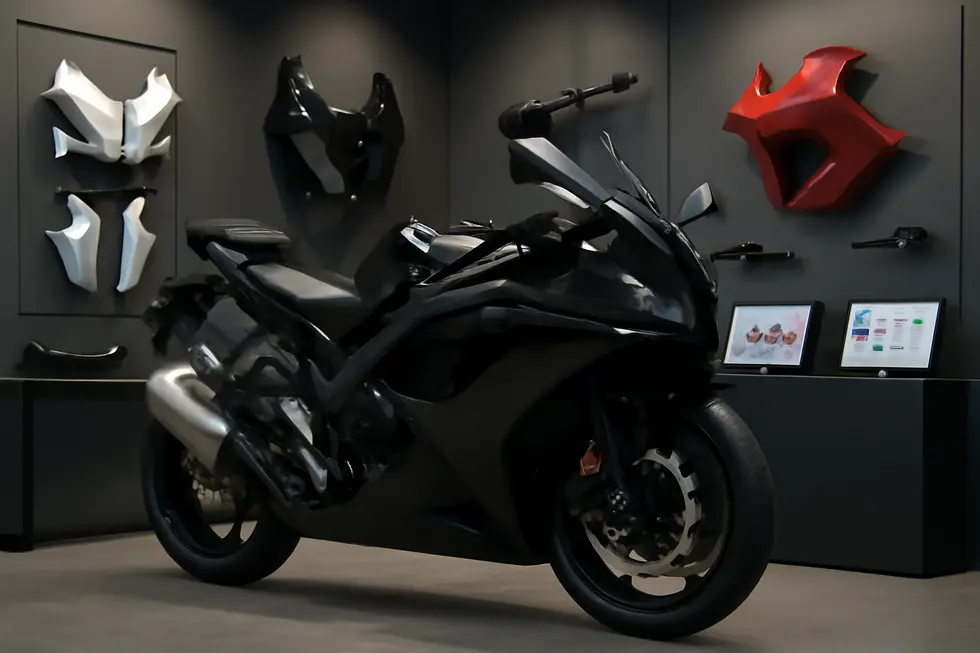Mastering Motorcycle Fairing Cleaner: Essential Insights for Business Owners
October 5, 2025 | by summitfairings
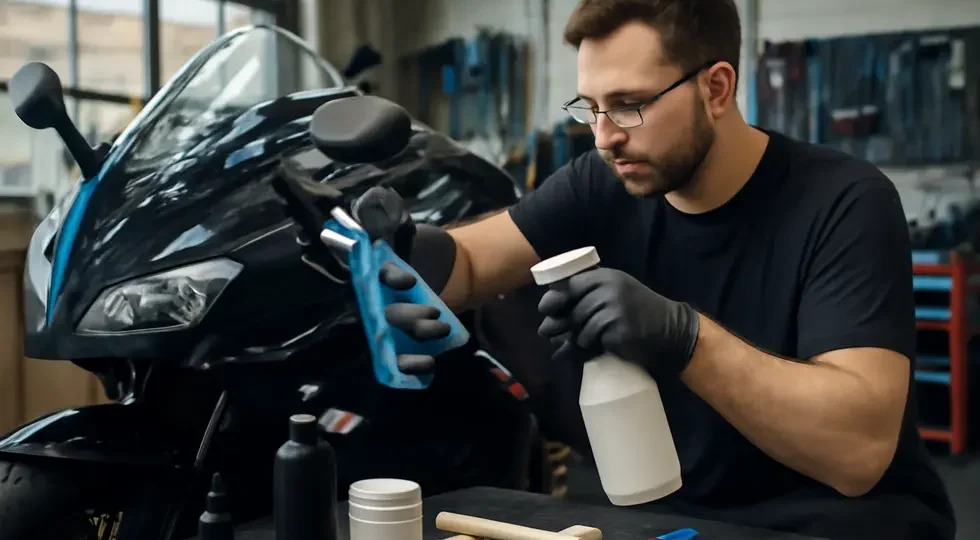
Introduction
Motorcycle fairings are vital not only for performance and aerodynamics but also as key aesthetic elements that reflect a brand’s quality and care. For business owners in the motorcycle industry, understanding the nuances of motorcycle fairing cleaners is pivotal to delivering exceptional service and product longevity. These specialized cleaners go beyond basic washing by carefully removing dirt, bugs, and grime while preserving delicate surfaces like painted and clear-coated plastics or fiberglass. This guide unpacks four critical facets to equip business owners with practical knowledge: the chemical makeup and cleaning mechanisms of these cleaners; application techniques and tools for optimal results; chemical safety and protective measures crucial for staff and customer safety; and finally, strategies for ongoing maintenance, repair, and enhancing the durability of fairings. Together, these insights empower businesses to maintain premium appearances, reduce repair costs, and build customer trust through expert surface care.
Tables of Contents
Chapter 1: Motorcycle Fairing Cleaner: Composition and Cleaning Mechanisms
- Gentle Yet Effective: The Role of Mild Detergents and Surfactants in Fairing Cleaners
- How Emulsification and Gentle Agitation Power Effective Dirt Removal from Motorcycle Fairings
- Ensuring Material Safety: Tailoring Cleaners for ABS, Fiberglass, and Carbon Fiber Fairings
- Mastering Microfiber Cloths and Application Techniques to Preserve Motorcycle Fairings
- Integrating Protective Technologies in Advanced Motorcycle Fairing Cleaners
Chapter 2: Techniques and Tools for Effective Motorcycle Fairing Cleaner Application
- Mastering Gentle Cleaning Techniques to Preserve Motorcycle Fairing Finish and Strength
- Essential Tools and Techniques for Safely Cleaning Motorcycle Fairings
- Harnessing Waterless Cleaners: Efficient and Eco-Friendly Motorcycle Fairing Care
- Mastering Tough Grime Removal: Expert Approaches for Stubborn Dirt and Bug Splats on Motorcycle Fairings
- Mastering Microfiber Cloths and Soft Brushes for Gentle, Thorough Fairing Care
Chapter 3: Chemical Safety and Protective Measures in Using Motorcycle Fairing Cleaner
- Choosing Mild Chemicals and Safe Practices to Protect Motorcycle Fairings
- Essential Personal Protective Equipment and Safety Protocols for Handling Motorcycle Fairing Cleaners
- Optimizing Ventilation and Environmental Controls for Safe Motorcycle Fairing Cleaning
- Safe Handling and Application Techniques for Effective Motorcycle Fairing Cleaning
- Optimizing Maintenance, Storage, and Inspection to Ensure Safe and Effective Use of Motorcycle Fairing Cleaners
Chapter 4: Maintenance, Repair, and Longevity Enhancements with Motorcycle Fairing Cleaner
- Enhancing Fairing Durability and Shine through Targeted Surface Care
- Optimizing Motorcycle Fairing Repairs Through Essential Pre-Repair Cleaning Practices
- Safeguarding Motorcycle Fairings Against Long-Term Wear Through Proper Cleaning and Repairs
- Gentle Power: How Neutral pH Cleaners Simplify Motorcycle Fairing Care and Extend Durability
- How Motorcycle Fairing Cleaner Preserves Structural Integrity and Rider Safety
Chapter 1: Motorcycle Fairing Cleaner: Composition and Cleaning Mechanisms
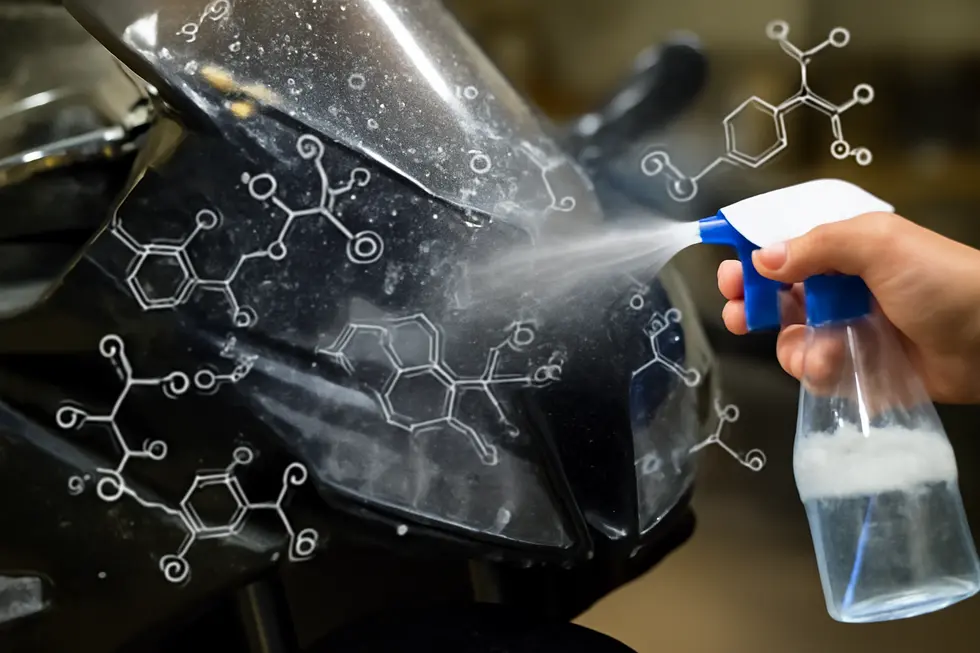
1. Gentle Yet Effective: The Role of Mild Detergents and Surfactants in Fairing Cleaners
Motorcycle fairing cleaners achieve their balance of safety and efficacy through carefully crafted chemical compositions. Central to these formulations are mild detergents and surfactants designed to lift dirt, bugs, and grime without harming delicate plastics, paints, or composite surfaces. Typically, these products employ non-ionic or mild anionic surfactants that reduce surface tension, allowing contaminants to be gently loosened and washed away without abrasive scrubbing. The presence of water-based solvents aids in dissolving oily residues while maintaining compatibility with the fairing’s finish.
Equally important is the maintenance of a neutral pH, generally around 7, with buffering agents that prevent acidic or alkaline damage to paint or plastic parts. This neutral balance ensures the cleaner is tough on grime yet kind to the motorcycle’s exterior. Additional ingredients might include corrosion inhibitors or mild fragrances to enhance user experience without compromising protection.
This carefully balanced chemistry ensures fairing cleaners effectively cleanse while safeguarding surfaces from streaks, fading, or scratches, forming the foundation for the next step in dirt and residue removal. For more on maintaining the aesthetics and integrity of your motorcycle components, explore this guide on explore the best motorcycle fairings at Summit Fairings.
2. How Emulsification and Gentle Agitation Power Effective Dirt Removal from Motorcycle Fairings
Chemical and Physical Actions in Motorcycle Fairing Cleaning work in tandem to deliver thorough, safe cleaning. The key chemical driver is emulsification, where surfactants reduce surface tension and bind to oily contaminants embedded on plastic or fiberglass surfaces. These molecules have hydrophobic tails that latch onto grease, while hydrophilic heads attract water, breaking down grime into stable, suspended droplets within the cleaner. This suspension prevents dirt from re-adhering to the fairing. Complementing this, physical action through gentle wiping or soft scrubbing helps lift and separate loosened dirt from the surface without abrasion. Finally, rinsing flushes away emulsified particles, leaving the fairing pristine. This balanced synergy avoids harsh chemicals or abrasive methods that risk damaging delicate finishes, making the cleaning process efficient yet gentle. Such a combined approach aligns with general principles used for other plastic components and ensures preservation of a motorcycle’s visual appeal. For practical tips on maintaining clean fairings and care guidance, explore resources like those found at Explore the Best Motorcycle Fairings at Summit Fairings.
3. Ensuring Material Safety: Tailoring Cleaners for ABS, Fiberglass, and Carbon Fiber Fairings
Motorcycle fairing cleaners must be thoughtfully formulated to protect ABS plastic, fiberglass, and carbon fiber materials from damage like discoloration, warping, or weakening. ABS fairings, prevalent for their balance of durability and cost, require cleaners free from harsh solvents that could disrupt their matte or glossy finishes and structural stability. Fiberglass fairings, often customized, benefit from gentle detergents that clean without causing cracks or surface dulling. Carbon fiber fairings, prized for their strength and lightweight design, demand chemically mild cleaners with UV protection to preserve both resin and fiber integrity. Using a compatible cleaner also supports proper surface preparation before applying coatings or adhesives, crucial for maintaining the fairing’s durability. Additionally, treatments such as ceramic coatings perform best when preceded by a cleaner that does not interfere with resin surfaces. Selecting a cleaner that balances efficacy with material safety ensures the longevity and aesthetics of each fairing type. For deeper insights on motorcycle fairing options and care, explore reliable resources available at Summit Fairings’ blog.
4. Mastering Microfiber Cloths and Application Techniques to Preserve Motorcycle Fairings
The use of microfiber cloths is essential in cleaning motorcycle fairings to prevent surface damage such as scratches, swirl marks, and lint deposits. These cloths feature soft, non-abrasive fibers that gently lift dirt and grime without harming delicate finishes like paint or clear coats, which are common on plastic and fiberglass fairings. For optimal results, always select high-quality microfiber cloths specially designed for automotive detailing, as inferior materials can introduce scratching or leave residues. Applying the cleaner to the cloth rather than spraying directly onto the fairing helps control product usage and minimizes streaking or oversaturation. Employing gentle, overlapping wiping motions prevents abrasive action on sensitive surfaces. Working in shaded or cooler environments is also crucial to avoid rapid drying, which can leave difficult residues or streaks that may degrade the finish. Using separate microfiber cloths for different stages of cleaning—for applying cleaner, buffing, and drying—reduces the chance of re-depositing dirt. Regular washing and proper care of microfiber cloths maintain their softness and effectiveness, preventing embedded grit from harming the fairing surface. Following these careful techniques supports the longevity of protective coatings and glossy finishes, especially on materials that require delicate handling, such as carbon fiber or UV-coated panels. For enthusiasts interested in deeper insights, further guidance on microfiber cloth application and specialized cleaning can be found in detailed motorcycle care sources, such as the comprehensive motorcycle fairings blog.
5. Integrating Protective Technologies in Advanced Motorcycle Fairing Cleaners
Advanced motorcycle fairing cleaners transcend basic grime removal by incorporating features that actively preserve and protect fairing surfaces. Central to these innovations are UV blockers that shield plastic or fiberglass fairings from sun-induced fading and cracking, maintaining vivid color and material strength. Additionally, hydrophobic agents create water-repellent layers that minimize dirt adhesion, enabling effortless cleaning and improving resistance to moisture-related degradation. These cleaners are thoughtfully formulated to complement ceramic coatings and paint protection films, safeguarding the integrity of these durable shields and enhancing their longevity. Non-abrasive compounds within these products restore shine gently without introducing haze or scratches, essential for the often delicate finishes of motorcycle fairings. Furthermore, some systems include protective sprays or sealants that add a sacrificial barrier, reducing damage from road debris and minor abrasions. For fairings requiring repair, adhesives selected for UV resistance, flexibility, and water tightness ensure lasting bonds under riding stresses. This multifaceted approach blends cleansing efficacy with surface defense, optimizing both the appearance and durability of motorcycle fairings. Learn more about care strategies in our article on explore the best motorcycle fairings at Summit Fairings.
Chapter 2: Techniques and Tools for Effective Motorcycle Fairing Cleaner Application
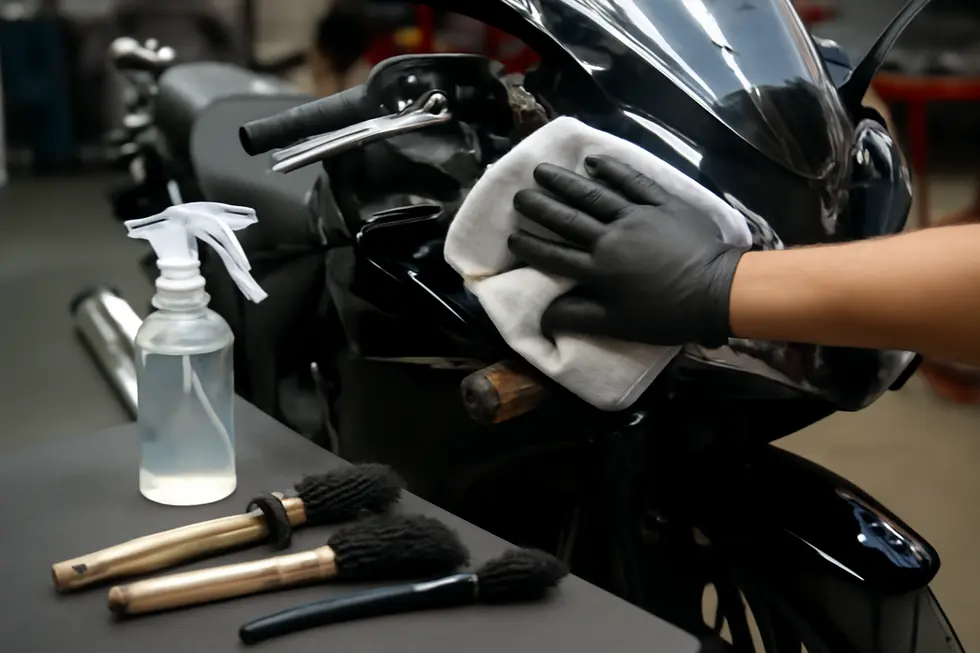
1. Mastering Gentle Cleaning Techniques to Preserve Motorcycle Fairing Finish and Strength
Applying motorcycle fairing cleaner effectively means balancing thorough dirt removal with preserving the fairing’s appearance and durability. Start by pre-soaking tough residues like bug splatter to loosen debris without causing scratches. Choosing a neutral pH or specialized fairing cleaner ensures that paints and plastics remain unharmed and free of streaks. Use soft microfiber wash mitts or detailing brushes to gently agitate dirt, especially on curved surfaces and vents, avoiding abrasive scrubbing that can damage delicate finishes. After cleaning, surfaces should be fully degreased before any adhesive application when repairing cracks, using automotive-grade glues designed for plastics to maintain strength without mess. Waterless cleaners serve well for quick touch-ups, lifting grime while protecting the surface and saving time. Regular maintenance with gentle cleaning agents prevents build-up that could degrade paint or plastic over time. Combining these careful methods preserves both the shine and structural integrity of your motorcycle fairings. For more on effective cleaning routines, visit the Summit Fairings blog.
2. Essential Tools and Techniques for Safely Cleaning Motorcycle Fairings
Achieving a thorough, scratch-free clean on motorcycle fairings relies on using specialized tools that complement the cleaner’s gentle formulation. Soft microfiber cloths stand out as indispensable, offering excellent absorption and minimizing swirl marks during application and removal of the cleaner. Spray bottles or precise applicators ensure an even, controlled distribution of cleaning liquids, avoiding waste and runoff. To navigate the complex shapes and tight crevices of fairings, soft detailing brushes delicately dislodge grime without harming paint or decals. Foam applicators enable smooth and streak-free spreading of polishes or treatments, especially over curved surfaces. Rinsing with a gentle water spray preserves the fairing’s finish without applying damaging high pressure. Finally, drying with clean towels or chamois prevents water spots and streaking. While general motorcycle toolkits rarely include these cleaning-specific items, investing in quality microfiber cloths and soft brushes is vital. This combination of tools facilitates a safe, effective, and gentle cleaning process aligned with best practices. For deeper insights, explore comprehensive motorcycle cleaning techniques at Summit Fairings’ resources.
3. Harnessing Waterless Cleaners: Efficient and Eco-Friendly Motorcycle Fairing Care
The integration of waterless cleaners into motorcycle fairing maintenance revolutionizes traditional cleaning methods by offering a water-conserving and gentle alternative. These advanced formulas effectively lift dirt, bug residue, and road grime without harmful abrasives or harsh chemicals, ensuring the protection of delicate plastic and painted surfaces. When paired with soft microfiber cloths, waterless cleaners facilitate a process that minimizes scratching risks while thoroughly removing contaminants. Riders benefit from the ease of quick application—spraying the cleaner, gently wiping with microfiber, and buffing to a glossy finish—making it ideal for on-the-go touch-ups or locations with water restrictions. Some waterless formulations further enhance the fairing’s durability by adding a protective wax layer, reducing future cleaning frequency and shielding against UV exposure. This efficient combination balances thorough cleaning with surface preservation, aligning perfectly with techniques aimed at maintaining both appearance and longevity. For deeper insights into motorcycle fairing care, enthusiasts can explore expert tips and product suggestions from dedicated sources focused on high-quality fairings.
4. Mastering Tough Grime Removal: Expert Approaches for Stubborn Dirt and Bug Splats on Motorcycle Fairings
Effective cleaning of motorcycle fairings, especially when facing stubborn dirt and accumulated bug splats, demands both careful technique and specialized tools. Starting with a pre-soak of a gentle, purpose-formulated cleaner softens grime, allowing safe lifting of residues without abrasion. Waterless cleaners excel here, enabling quick cleaning while protecting paint and plastics. Following that, gentle agitation using soft microfiber cloths or foam pads carefully removes loosened dirt. For particularly tenacious bug splatter, specialized bug sponges designed to trap and lift while being nonabrasive are invaluable. Complex contours and vents benefit from soft-bristled detail brushes that dislodge grime from tight spaces without scratching delicate finishes. Mild degreasers may be applied for oily or tar-like deposits, but must be promptly removed by rinsing or microfiber wiping. Drying with a clean microfiber towel prevents water spots, and applying a paint- or plastic-safe polish afterward helps protect surfaces against future buildup and UV damage. Testing products on inconspicuous spots and avoiding harsh tools ensures fairing integrity. For more insights on maintaining and protecting these components, explore the detailed motorcycle fairings resources.
5. Mastering Microfiber Cloths and Soft Brushes for Gentle, Thorough Fairing Care
Microfiber cloths and soft-bristled brushes are essential tools for preserving motorcycle fairings while ensuring deep cleaning. Microfiber’s fine, gentle fibers trap dirt and contaminants effectively, minimizing scratches on delicate plastic and painted surfaces. Using clean, dry microfiber cloths to buff after cleaning guarantees a streak-free, polished finish. Soft brushes excel at reaching grimed crevices, vents, and textured areas, lifting stubborn dirt without abrasion. Begin the cleaning process by rinsing the fairing with water or waterless cleaner to remove loose debris. Apply a mild detergent or specialized fairing cleaner with either microfiber cloth or soft brush, gently agitating textured areas with the brush. Avoid abrasive sponges and harsh chemicals that can dull or damage surfaces. Afterward, thoroughly dry and polish the fairing with a dry microfiber cloth to prevent water spots and preserve shine. Maintaining separate cloths for cleaning and drying protects against dirt redepositing and prolongs tool life. Consistent use of these tools balances effective grime removal with surface protection, extending the life and appearance of motorcycle fairings. For further insights on fairing care, explore detailed guides on explore the best motorcycle fairings at Summit Fairings.
Chapter 3: Chemical Safety and Protective Measures in Using Motorcycle Fairing Cleaner
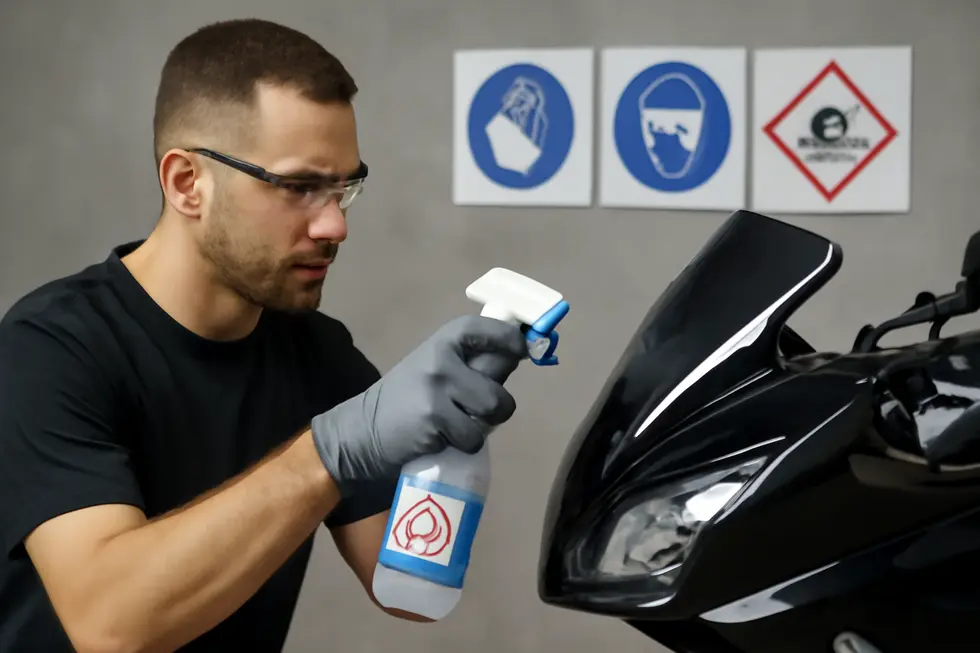
1. Choosing Mild Chemicals and Safe Practices to Protect Motorcycle Fairings
Maintaining the integrity of motorcycle fairings begins with selecting mild, pH-neutral cleaners designed specifically for automotive plastics and painted surfaces. These solvent-free and non-abrasive formulations ensure effective removal of dirt, bug residue, and grime without causing fading or surface degradation. Harsh acids, alkalis, or abrasive agents must be avoided, as they can weaken plastic, damage clear coats, or cause brittleness over time. Regular cleaning with gentle soap-and-water solutions supplemented by UV-protective sprays helps preserve the fairing’s appearance and durability, shielding it from sunlight and moisture damage. Equally important are protective measures during use: wearing gloves and eye protection prevents skin and eye irritation, while applying cleaners with soft microfiber towels avoids scratching delicate surfaces. Working in well-ventilated areas minimizes inhaling any fumes from even mild chemicals, and spills of fuel or solvents should be promptly cleaned to prevent damage to adhesives or coatings. Incorporating these gentle chemical choices and careful handling practices allows riders to uphold both chemical safety and the lasting beauty of their motorcycle fairings. For more insights on compatible cleaning options, visit the Summit Fairings’ blog.
2. Essential Personal Protective Equipment and Safety Protocols for Handling Motorcycle Fairing Cleaners
Ensuring safety while using motorcycle fairing cleaners requires diligent use of personal protective equipment (PPE) and adherence to key safety protocols. Gloves made from latex or nitrile form a crucial barrier that prevents skin irritation or allergic reactions from solvents and cleaning agents frequently present in these products. Equally important is working within a well-ventilated environment, which minimizes inhalation risks from volatile compounds. Instead of spraying cleaners directly onto plastic or painted surfaces, it’s safer to apply them onto lint-free cloths first; this controlled application limits chemical exposure and protects the finish. Users should always follow manufacturer instructions closely, conducting a patch test on a discreet area to confirm compatibility and avoid damage. Proper disposal of used materials helps prevent environmental hazards and accidental exposure. Avoiding open flames in proximity to these potentially flammable cleaners or adhesives is imperative. Together, these precautions provide comprehensive protection for both the user and the motorcycle’s delicate surfaces, aligning with broader chemical safety standards. For further insights into fairing care, see a wide range of expertise at the Summit Fairings blog.
3. Optimizing Ventilation and Environmental Controls for Safe Motorcycle Fairing Cleaning
Effective use of motorcycle fairing cleaners demands strict attention to ventilation and environmental controls to ensure chemical safety. Cleaning should be performed in well-ventilated areas—preferably outdoors or near open windows and doors—to dissipate volatile organic compounds (VOCs) and reduce inhalation hazards. Mechanical aids such as fans or exhaust systems enhance air circulation, minimizing the buildup of potentially harmful vapors. Alongside maintaining air quality, using protective gloves and eye gear complements ventilation by guarding against skin and eye irritation caused by chemical contact. Avoid enclosed or poorly ventilated spaces, as they increase risk from fumes. Proper storage away from direct sunlight and extreme temperatures preserves cleaner stability and limits unintended chemical reactions. Equally crucial is responsible disposal to prevent environmental contamination. Following manufacturer guidance on application and exposure time optimizes safety. Adhering to these measures aligns with best practices in motorcycle maintenance, ensuring both user protection and cleaner effectiveness. For expanded insights on chemical safety during fairing care, see comprehensive tips on motorcycle fairings and safety precautions.
4. Safe Handling and Application Techniques for Effective Motorcycle Fairing Cleaning
Ensuring chemical safety when using motorcycle fairing cleaner begins with careful handling and application techniques tailored to protect both the rider and the bike. Selecting cleaners specifically formulated for motorcycle plastics helps avoid damage caused by harsh chemicals. Instead of spraying directly on surfaces, applying the cleaner onto a soft, lint-free cloth before wiping prevents overexposure and uneven chemical contact. Using gentle tools like microfiber cloths or soft sponges preserves the finish and avoids scratches on delicate painted or clear-coated fairings. Wearing gloves and eye protection minimizes direct chemical contact, while working in well-ventilated spaces reduces inhalation risks from fumes. Preparing the surface by removing grease and dirt before cleaning improves effectiveness and safeguards the material. Always following manufacturer instructions ensures proper use and avoids unintended damage. Safe storage and environmentally responsible disposal of chemical products complete the protective practices. These combined techniques maximize cleaning results without compromising safety or the integrity of motorcycle fairings. For more insights on proper motorcycle fairing care, explore detailed guides available at Summit Fairings’ blog.
5. Optimizing Maintenance, Storage, and Inspection to Ensure Safe and Effective Use of Motorcycle Fairing Cleaners
Ensuring chemical safety and protection when using motorcycle fairing cleaners requires diligent maintenance, storage, and inspection practices. Begin by inspecting the fairing for cracks or scratches, preventing further damage during cleaning. Use cleaners formulated specifically for motorcycle plastics and wear gloves while working in well-ventilated areas to minimize skin contact and inhalation risks. Avoid aerosol sprays on sensitive plastic parts; liquid or foam cleaners applied with soft cloths offer better control and reduce overspray. Store motorcycles in cool, dry environments away from sunlight and extreme temperatures to preserve fairing integrity. Cleaning chemicals should remain tightly sealed, stored separately from heat sources or incompatible materials to maintain safety and effectiveness. Regularly check the fairing’s fasteners and mounting points to prevent loosening from vibrations or cleaning processes. After cleaning, thoroughly inspect for residue or damage and always test products on small, hidden areas first. For extra protection, consider applying films or coatings on vulnerable spots. Following these integrated strategies supports the longevity and safe upkeep of both the fairing and cleaning agents, enhancing your overall maintenance routine. For comprehensive care tips, visit this source on motorcycle fairings and maintenance.
Chapter 4: Maintenance, Repair, and Longevity Enhancements with Motorcycle Fairing Cleaner
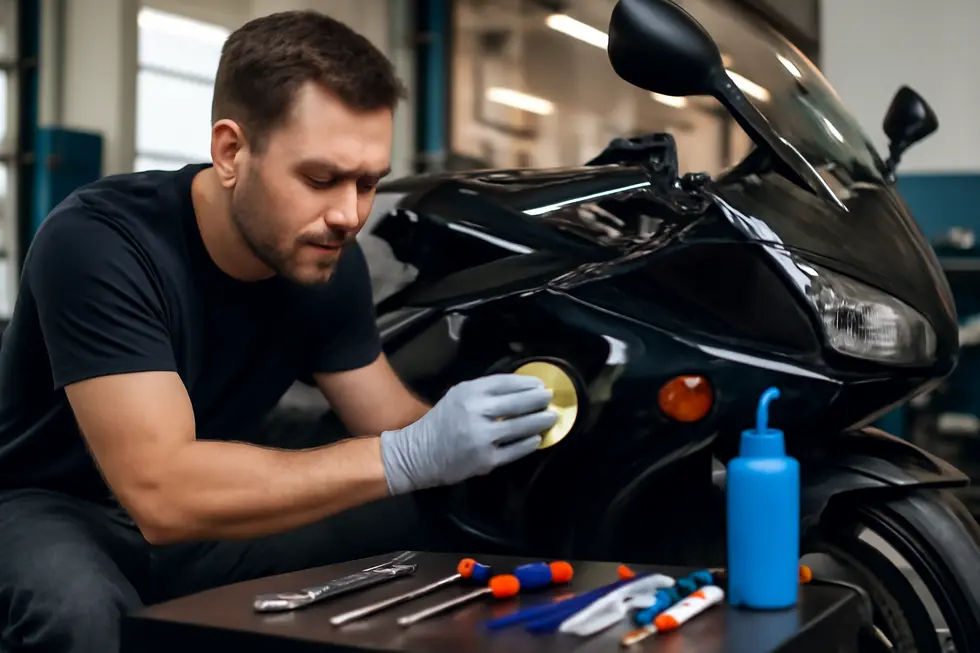
1. Enhancing Fairing Durability and Shine through Targeted Surface Care
Motorcycle fairings demand careful surface care to preserve both functionality and visual appeal. These components face relentless exposure to UV rays, road debris, bug splatter, and environmental contaminants that accelerate deterioration and fading. Using a motorcycle fairing cleaner formulated with gentle detergents safeguards paint and clear coats while lifting grime without scratching. Prompt attention to surface imperfections—such as scratches or cracks—is critical; automotive-grade epoxy adhesives provide durable, vibration-resistant repairs that maintain structural integrity and aerodynamic performance. Beyond cleansing and repair, applying advanced protective coatings like ceramic layers offers extended defense against UV damage, water spots, oxidation, and corrosive elements, thereby simplifying routine maintenance. Paint protection films add a transparent, impact-resistant barrier ideal for vulnerable fairing sections, preserving the bike’s sleek look. Regular inspections ensure fasteners remain secure, preventing damage via loosened parts. Embracing these practices maintains the fairing’s gloss and strength over time, prolonging its lifespan while enhancing the motorcycle’s overall presentation. For detailed insights into motorcycle fairings and their upkeep, visit this resource on fairing selection and maintenance.
2. Optimizing Motorcycle Fairing Repairs Through Essential Pre-Repair Cleaning Practices
Effective motorcycle fairing repairs rely heavily on thorough pre-repair cleaning to ensure long-lasting results. A dedicated motorcycle fairing cleaner removes stubborn dirt, grease, and road contaminants that impair adhesive bonding and obscure damage detection. By eliminating oils and grime, these cleaners enhance the adhesion of automotive-grade epoxy adhesives, crucial for preventing joint failures or stress fractures over time. Clean surfaces also enable sharper inspection of cracks or wear, allowing precise, targeted maintenance efforts. Importantly, using gentle, motorcycle-specific cleaning agents paired with soft microfiber cloths preserves the fairing’s paint and plastic finishes, protecting its aesthetic and structural integrity. Following cleaning, applying quality adhesives guarantees durable, water-resistant bonds essential for withstanding environmental stress. Routine cleaning combined with protective treatments extends fairing lifespan by reducing exposure to UV damage and grime buildup. This foundational step in fairing upkeep maximizes repair efficiency, improves component durability, and supports overall motorcycle longevity. For comprehensive product tips and repair guidance, explore expert resources dedicated to motorcycle fairings.
3. Safeguarding Motorcycle Fairings Against Long-Term Wear Through Proper Cleaning and Repairs
Motorcycle fairings require careful maintenance to prevent long-term damage and preserve their appearance. Using a cleaner specifically formulated for delicate surfaces is crucial. These products are pH balanced to remove dirt and grime without stripping protective waxes, clear coats, or degrading plastic and rubber components. Avoid harsh household soaps that can accelerate fading and corrosion. For repairs, automotive-grade epoxy adhesives offer strong, water-resistant bonds that endure vibration and weather exposure while maintaining the fairing’s structural integrity. Properly applied, they help extend the life of cracked or damaged plastic parts, reducing the need for premature replacements. After cleaning, rinsing thoroughly and drying preserves finishes and prevents mineral deposits that cause etching. Applying protective wax or sealants adds a barrier against UV rays and environmental contaminants, enhancing longevity. Together, these practices ensure fairings maintain their fit, finish, and strength. For more insights on comprehensive care and sourcing quality plastic fairings, exploring your ultimate source for affordable motorcycle fairings can provide valuable guidance.
4. Gentle Power: How Neutral pH Cleaners Simplify Motorcycle Fairing Care and Extend Durability
Neutral pH cleaners strike a vital balance between effective cleaning and surface preservation for motorcycle fairings. Unlike harsh detergents, these gentle formulations remove dirt, grime, and bug residues without compromising the integrity of paint, plastics, or metal parts. By using neutral pH products regularly—paired with soft microfiber cloths—riders can prevent the gradual wear and corrosion otherwise caused by acidic or alkaline chemicals. This mild yet thorough cleaning process reduces micro-scratches and fading, which often complicate later repairs. Moreover, maintaining a clean surface with neutral pH cleaners helps preserve the aerodynamic function and aesthetic appeal essential to the fairing’s performance and rider safety. The ease of maintenance afforded by these cleaners also supports longer intervals between costly repairs or replacements. For more insights into caring for your bike’s exterior components, explore expert advice on motorcycle fairings at Summit Fairings.
5. How Motorcycle Fairing Cleaner Preserves Structural Integrity and Rider Safety
Motorcycle fairing cleaner is vital for preserving both the structural integrity of fairings and rider safety. Fairings, often crafted from ABS plastic or fiberglass, act as shields against debris, UV rays, and weather exposure. Using a dedicated cleaner removes grime, bug residue, and oils without damaging paint or plastic surfaces, preventing premature fading, cracking, or weakening. This maintenance protects the fairings’ aerodynamic profile, which directly influences stability and control while riding. Clean, smooth surfaces reduce air resistance, helping maintain performance and safety at speed. Moreover, regular cleaning paired with protective treatments like wax or advanced coatings strengthens the fairing’s durability against corrosion and oxidation. These layers repel dirt and moisture, making future cleanings easier and preserving the glossy finish that contributes to aerodynamic efficiency. By safeguarding the fairing’s material and protecting underlying components, consistent use of appropriate cleaners reduces costly repairs and enhances the motorcycle’s lifespan. This balance between effective grime removal and gentle care ultimately supports safer rides and longer-lasting motorcycles. For more insights into quality fairings and maintenance, explore Summit Fairings’ expert resources.
Final thoughts
Businesses that prioritize expert knowledge in motorcycle fairing cleaning and maintenance gain a significant edge in quality assurance and customer satisfaction. Understanding the unique composition and gentle cleaning mechanisms of these specialized products safeguards the integrity of delicate fairing surfaces, thereby enhancing product lifespan and appeal. Skillful application using the right tools not only ensures thorough contaminant removal but also minimizes risks of damage. Incorporating stringent chemical safety practices protects personnel and clients alike, fostering a professional and trustworthy environment. Moreover, integrating routine maintenance and minor repairs alongside cleaning extends the fairing’s durability and aesthetic value while reducing costly replacements. Together, these insights equip business owners to deliver superior care, improve operational efficiency, and solidify their brand reputation in the competitive motorcycle market.
Ready to elevate your ride? Summit Fairings delivers premium, custom-fit fairings that blend style and durability. Whether you’re chasing speed or turning heads, we’ve got your bike covered. Don’t wait—transform your machine today. Click, customize, and ride with confidence. Your perfect fairing is just a few clicks away. Act now!
About us
undefined
RELATED POSTS
View all

